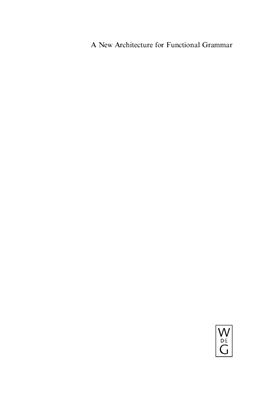Mouton de Gruyter, 2004, ISBN 3-11-017356-5.
This volume arises indirectly from the Ninth Inteational Conference on
Functional Grammar (ICFG9), which was held at the Universidad National
de Educaci?n a Distancia (UNED), Madrid, from 20 to 23 September 2000.
Some of the chapters derive from papers given there, others have been specially
commissioned. This book addresses, and offers solutions to, a
problem that was keenly felt at that conference: Functional Grammar (FG),
the model of the organization of human languages proposed by the late
Simon Dik, was failing to achieve one of its central ambitions, to account
for regularities of form that are attributable to the use of language in discourse.
The first chapter of this volume, by Kees Hengeveld of the University
of Amsterdam (Netherlands), proposes that the solution to the problem lies
in tuing the original model on its head. He rejects the bottom-up approach,
which started with the individual predicate and worked upwards to
a fully specified underlying representation, in favour of a top-down approach,
which takes the speaker’s intention to communicate as its starting
point. At the same time, he develops suggestions in Dik’s posthumous
work that a FG should have a modular architecture, proposing three levels
of analysis for each discourse unit to be analysed: the interpersonal, the
representational and the expression levels. Within each of these levels, the
nesting of layers which came to be the trademark of FG in the nineties has
been preserved. Hengeveld sketches various ways in which this architecture,
to be known as Functional Discourse Grammar (FDG), is more
adequate than the previous model, by showing how it can account for phenomena
involving interactions between levels.
This volume arises indirectly from the Ninth Inteational Conference on
Functional Grammar (ICFG9), which was held at the Universidad National
de Educaci?n a Distancia (UNED), Madrid, from 20 to 23 September 2000.
Some of the chapters derive from papers given there, others have been specially
commissioned. This book addresses, and offers solutions to, a
problem that was keenly felt at that conference: Functional Grammar (FG),
the model of the organization of human languages proposed by the late
Simon Dik, was failing to achieve one of its central ambitions, to account
for regularities of form that are attributable to the use of language in discourse.
The first chapter of this volume, by Kees Hengeveld of the University
of Amsterdam (Netherlands), proposes that the solution to the problem lies
in tuing the original model on its head. He rejects the bottom-up approach,
which started with the individual predicate and worked upwards to
a fully specified underlying representation, in favour of a top-down approach,
which takes the speaker’s intention to communicate as its starting
point. At the same time, he develops suggestions in Dik’s posthumous
work that a FG should have a modular architecture, proposing three levels
of analysis for each discourse unit to be analysed: the interpersonal, the
representational and the expression levels. Within each of these levels, the
nesting of layers which came to be the trademark of FG in the nineties has
been preserved. Hengeveld sketches various ways in which this architecture,
to be known as Functional Discourse Grammar (FDG), is more
adequate than the previous model, by showing how it can account for phenomena
involving interactions between levels.

